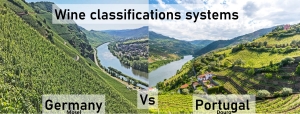The Classification system in Portugal vs. Germany
The system
The wine classification systems in the European Union are largely based on geographical origin, production processes, and grape varieties used in winemaking. This approach is present in most European countries with more or less variations and levels. In Germany, the classification also takes into account the ripeness level of grape at the time of harvest. This factor influences the sweetness of the final product. The goal for this article is to draw possible parallels between the wine classification systems in Portugal and Germany.
The basic
“Deutscher Wein” (German wine) is the most basic category in Germany and does not have specific quality requirements, other than the grapes being produced in Germany. In Portugal, the lowest level of classification is called “vinho” or “vinho de mesa” (table wine). In this category, regulatory requirements are minimal. I would like to point out that the designation “vinho de mesa” is also used in other European countries (e.g., Italy – Vino da Tavola) for the lowest level on the wine quality scale.
The next step
The second level of quality in Portugal is “vinho regional” (VR), which includes all wine produced in defined areas within the Portuguese territory. The regulations for VR wines are less strict compared to higher classifications, allowing for more flexibility in winemaking techniques and grape varieties. I can state that there is some parallelism with the wine category called “Landwein” in Germany. These wines have slightly stricter quality standards than “Deutscher Wein” (not only a more restricted region but also limitations on yield/production and grape variety).
The stricter regulations
If we want to find the category that has the most similarities in both countries, we have to compare wines designated as “Qualitätswein bestimmter Anbaugebiete” (QbA – Quality wine from specific regions) and Portuguese wines designated as wines with controlled designation of origin (DOC – Denominação de Origem Controlada). Both QbA and DOC represent quality wines from specific regions (in the Portuguese case, called “demarcated” regions). Both have stricter regulations regarding grape varieties, production practices, yield, and winemaking. Wines included in these categories have to be approved by a tasting panel to ensure their quality. This is the highest category of wine in Portugal.
In Portugal, there is another category that I would like to mention – IGP wines (Indicação Geográfica Protegida), which is an intermediate class between VR and DOC wines. IGP wines are very similar to DOC wines in almost every aspect, although their regulations are less strict, both in terms of grape varieties used and production and verification processes.
The top
In Germany, there is also a superior category called “Prädikatswein,” based on the level of grape ripeness at harvest. Here we find six subtypes, which I will list in increasing order of sweetness: Kabinett, Spätlese, Auslese, Beerenauslese, Eiswein, Trockenbeerenauslese. I would like to emphasize that both wines classified as Beerenauslese and Trockenbeerenauslese are made from grapes affected by noble rot (grapes infected with the fungus Botrytis cinerea). Additionally, it is important to highlight the category of Eiswein, which, as the name suggests, is the result of grapes harvested at sub-zero temperatures (-7°C – frozen grapes).
Conformity or not?
In summary, although there is an effort to align the wine classification in the European Union, specificities persist (which, in my opinion, is appropriate) in national classifications. This allows the preservation of traditional culture and knowledge, protecting the identity of the wine, producer, region, and country.
João Correia


 D-30916
D-30916
 Eurosommelier.de
Eurosommelier.de